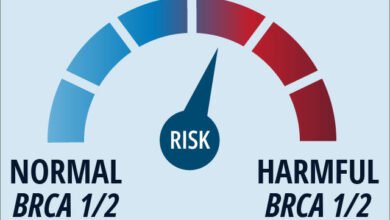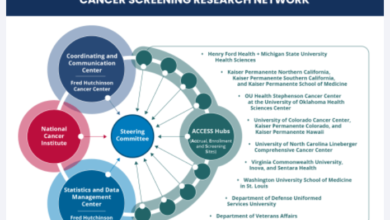Cancer Research UK – Science blog

Lung cancer cells seen through a microscope. Anne Weston, Francis Crick Institute (CC BY-NC 4.0)
For cancer researchers with news to share, there’s no place like ASCO.
The American Society for Clinical Oncology’s Annual Meeting, to give it its full name, is the world’s largest cancer conference. This year, it brought more than 40,000 of oncology’s best and brightest to Chicago. From 2nd to 6th June, as they do every year, they put themselves at the centre of the planet’s health news agenda.
It’s best to take the coverage of events like the ASCO Annual Meeting with a pinch of salt. Mostly, scientists give updates on ongoing trials. Their data is rarely final, and they usually have to explain it in a matter of minutes. Journalists don’t have much longer to turn those talks into stories. Details can get muddled, to say the least.
That’s why we’ve been looking through the headline studies, too. Here’s our pick of the most significant ones – with commentary from some of our experts.
Lung cancer drug halves risk of death for some patients
Osimertinib (also known as Tagrisso), a new drug from AstraZeneca, could reduce the risk of patients with early-stage non-small cell lung cancer (NSCLC) dying by 51%.
That’s according to results from the Phase 3 ADAURA trial, which looked at 682 patients with early-stage NSCLC. They all had mutations of a gene that increased production of a protein called epidermal growth factor receptor (EGFR), which can help cancers grow.

Osimertinib is a more effective treatment for some non-small cell lung cancers. David A Litman/Shutterstock.com
“Lung cancer is the most common cause of cancer death in the UK, and the majority of cases are non-small cell,” explained Professor Charles Swanton, our chief clinician. “However, treatment options remain incredibly limited and just 10% of people with the disease survive for 10 years or more. We urgently need more effective treatments with fewer side effects.”
Osimertinib, a pill taken once per day after surgery, is already approved for some patients in the UK. In the trial, 85% of NSCLC patients who took osimertinib were alive after five years, compared to 73% of those who weren’t treated with the drug.
This data builds on earlier results from the same study, which showed that osimertinib can halve the risk of NSCLC returning after treatment.
“This offers real hope for patients with early-stage disease with an EGFR activating mutation,” said Swanton, who also runs our flagship lung cancer study, TRACERx.
“The treatment landscape of lung cancer has been transformed over the last decade and it’s wonderful to see new treatment strategies coming through the pipeline for this hard-to-treat disease. Ultimately, research like this will bring us closer to a world where more people live longer, better lives, free from the fear of cancer.”
Treating bowel cancer without radiotherapy
Radiotherapy has been part of the standard treatment for bowel cancer for decades, but it can cause a range of difficult side effects. According to new data from the US, many patients whose tumours respond to chemotherapy might not need it.
Traditionally, bowel cancer patients are treated with radiotherapy, then surgery and finally chemotherapy. Now, doctors at the Memorial Sloan Kettering Medical Centre in New York have found that chemotherapy before surgery (with an option to continue it after) is just as effective.
This approach, which was tested in a trial involving 1,194 patients with bowel cancer that started in the back passage (rectum), also reduces long and short-term side effects.
People who have radiotherapy for bowel cancer can experience short-term side effects like diarrhoea, sickness, weight loss and bladder pain. Radiotherapy between the hips (pelvic radiotherapy) can also affect men’s and women’s sex lives and fertility. Over the long term, it can cause changes to bowel habits and pelvic bones.
“Pelvic radiotherapy is associated with major long-term side effects,” added Swanton. “I think avoiding radiation is a major step forward.”
“On the basis of this, I think you can say you can safely avoid radiotherapy for many patients with this disease. I think it’s definitely an advance.”
A new drug combo for some ovarian cancers
Around 1 in 10 women diagnosed with ovarian cancer have a form of the disease called low-grade serous ovarian cancer (LGSOC). Today, their treatment options are limited.
Another paper presented at ASCO – led by researchers at the The Royal Marsden NHS Foundation Trust and The Institute of Cancer Research, London – suggests a new combination of targeted drugs could change that.
Nearly half (45%) of patients treated with avutometinib and defactinib saw their tumours shrink significantly. That percentage is almost twice as high as the next best treatment.
Both drugs are designed to block signals that encourage cancer cells to grow.
On its own, avutometinib becomes less effective over time. Combining it with defactinib, which works to stop certain cancers resisting drug treatments, is a way to overcome that issue.
“It’s encouraging to see progress in therapies for this type of ovarian cancer, which is often hard to treat,” said Dr Catherine Elliott, our director of research and partnerships. “Studies like this can help us better understand how treatments can be targeted based on mutational signatures in cancers, and the results from this research are promising. “
This trial is still in its earlier phases, so there’s a lot more to find out before we know just what the new drug combination could do for patients.
“We look forward to seeing the next steps of this research on a much larger scale, in order to uncover how this treatment could affect not just tumour shrinkage, but long-term survival too,” Elliott added.
Managing side effects with yoga
Across two separate trials, researchers at the University of Rochester medical centre in New York found evidence that regular yoga sessions could help people cope with cancer symptoms and reduce side-effects from cancer treatment.

Yoga seen through a heat camera. Thermal Vision Research (CC BY 4.0)
The first study was a Phase 3 randomised control trial: the type used to study the effectiveness of drugs and other therapies. It tested yoga against a health education course across 500 people diagnosed with cancer in the past five years. Those who took part in two gentle 75-minute yoga sessions a week had lower levels of inflammation, which is associated with worse cancer outcomes, than those who didn’t.
In the other, earlier stage, study, 173 older patients who followed the same routine reported lower levels of fatigue and higher quality of life.
Caroline Geraghty, one of our specialist cancer information nurses, helped us understand what this means for people who aren’t taking part in research.
“While there is no scientific evidence to prove that yoga can cure or prevent any type of cancer, studies like these suggest that it might help people cope with symptoms and side effects,” she explained. “Some people with cancer find it helps to calm their mind, while others say it reduces tiredness and helps them move around more easily after surgery.”
For that to work, though, your yoga routine needs to match your fitness level.
“Before you begin any yoga practice, make sure that you tell your yoga teacher about your condition. They can adapt the exercises to suit your needs. It’s important to take things gently at first to minimise the risk of injury.”
The senior researcher for this work is Professor Karen Mustian, a member of the Cancer Grand Challenges team CANCAN. Cancer Grand Challenges is a joint funding initiative between Cancer Research UK and the National Cancer Institute in the US.
As part of CANCAN, which was awarded £20m ($25m) of funding in 2022, Mustian is helping us understand and treat cachexia, the debilitating wasting syndrome that affects many people with advanced cancer.
Latest updates on blood tests for detecting cancer
New drugs are good news, but we have to find cancers before we can treat them. And, year after year, nothing captures minds at ASCO like the promise of a ‘simple blood test’ for diagnosing cancer.
For 2023, the California company GRAIL served up the latest results from an NHS trial of its Galleri blood test. The technology can detect more than 50 types of cancer by looking for DNA that breaks off from tumour cells and moves through the blood. But there are still questions to answer about its accuracy
The Symplify study, led by the University of Oxford, tested it in 5,461 people in England and Wales who were referred to hospital with suspected cancer by their GPs.
The Galleri test correctly identified 66% of the cancer cases in the study, performing best for older patients and later stage cancers. In 85% of those cases, it was also able to locate where the cancer started.
Dr David Crosby, our Head of Prevention and Early Detection Research, talked us through what this means.
“This research has investigated how GRAIL’s multi-cancer early detection test can be used in people who have symptoms of cancer. The findings from the study suggest this test could be used to support GPs to make clinical assessments, but much more research is needed in a larger trial to see if it could improve GP assessment, and ultimately patient outcomes.”
The NHS has also been trialling the Galleri test in thousands of people without symptoms to see if it can detect hidden cancers. We’ll update you on those findings when they’re released.
Can AI help us understand cancer risk?
The Galleri test uses artificial intelligence (AI) to detect slight differences between healthy DNA in the blood and DNA carrying signs of cancer. That’s not the only way scientists are trying to use AI to protect us from the disease.

Using data from mammograms, AI tools may be able to help doctors estimate women’s risk of developing breast cancer. Okrasiuk/Shutterstock.com
One new study presented at ASCO showed that AI tools are better at predicting breast cancer risk than one of the standard clinical models used in the US.
Currently, health systems use information about family history, pregnancies and childbirths, breast density and more to assess breast cancer risk and decide how often to invite women for screening. That information can take time to gather. It isn’t always available, either. On the other hand, AI tools only need the data from mammograms.
Researchers used five different AI programmes to assess data from mammograms that showed no visible signs of cancer. All of them were all better at predicting 5-year breast cancer risk from these negative mammograms than the Breast Cancer Surveillance Consortium (BCSC) risk model.
In the 10% of women with the highest risk of breast cancer, the top-performing AI correctly predicted 28% of cases, compared to the 21% predicted using the BCSC model.
The lead researcher behind the study, Professor Vignesh A. Arasu, a research scientist and radiologist in California, said AI is showing promise as a “tool that could help us provide personalised, precision medicine on a national level.”
For now, though, there are still questions about why AI works, and how we should use it.
“This strong predictive performance over the five-year period suggests AI is identifying both missed cancers and breast tissue features that help predict future cancer development,” said Arasu. “Something in mammograms allows us to track breast cancer risk. This is the ‘black box’ of AI.”
Tim
Source link
#Cancer #Research #Science #blog



